[TrainingTalk] Amsterdam marathon: training and race report
A good day to close a crazy summer and even crazier race week

I love the marathon.
One of the few events that can be both long and high-intensity.
We can run for many hours, and we can run very hard, but doing both the way a marathon requires.. the difficulty might be one of the reasons why it is such a fascinating event, at least for me.
I remember the first time I finished one. I was in Napa Valley, in California, and at the end, I was so emotionally overwhelmed that I found myself crying.
The marathon drains me, maybe mentally more than physically. The months of training, preparations, miles splits, race-day execution.
Not an experience I can live more than once or twice per year.
I hope to have a few more of these days, but in the meantime, I'm taking it all in.
Below is my training and race report for the Amsterdam marathon, which I raced last week as a backup plan after getting sick in Chicago.
Training
My training at this point is mostly focused on my obsession (the 100 km del Passatore, the last Saturday of May, in Florence, Italy), and in very simple terms, I aim at getting as fit as possible until March, then do two months of very specific work (hills, heat, pacing, fueling) before the race. In the process of getting as fit as possible, nothing is better than training for a marathon, so I try to plan one in Autumn and one in Spring.
This year, after running the Biel 100 km in June (Passatore was canceled due to the floods in our region), I planned a summer of training targeting the Chicago marathon in October.
As it often happens, nothing went according to plan. I ended up getting injured, cycling a ridiculous amount of hours per week, getting sick twice on race week in Chicago, throwing up on the course, finding a last-minute bib for my home marathon on the following Sunday (Amsterdam), and racing a personal best.
But let’s go step by step.
High-level planning
After the Biel 100 km (race report here) I had planned some B and C races (parkrun, Veluwezoom trail, Winschoten 50 km), and planned to change my periodization to limit injury risk, as I have been broken or almost broken often in the past year (I discuss these changes in more detail here).
The goal was to do a bit of everything but not too frequently (cycling through VO2max, threshold, and marathon pace work), as opposed to the usual block periodization I have done in the previous years (which I discuss here).
I thought I could run a bit better than in Manchester (2h 59’), or a similar time but enjoying it more (being in less physical pain).
Injury and adjustments
Unfortunately, I got what I think was a minor tear in my calf after racing a parkrun all out (17’ 51”), somewhat recovered, then raced hard also at Veluwezoom a few weeks later (34 km on trails) and (big mistake) went for a double run the day after, ending up with a more serious tear and sidelined for a while.
It was mid-July, and I couldn’t run at all.
On the bright side, the calf injury was no problem on the bike, and so, I started cycling like I had never done before. I went from zero to 20 hours per week on the first week, then settled on about 25 hours per week until I also started running more. I’ll write something later about how I plan to combine cycling and running now, but those days I was extremely motivated in my attempt not to lose (running) fitness, and I thought I had to put in the time. I went for 8-hour rides, did intervals on the trainer, and tried to be consistent both with volume and intensity.
If you are interested, I discussed in more detail de-training and cross-training here and how the experiment went, here.
Below is my running training volume for the past months, you can easily spot the injury and also getting sick just the week I was in Chicago. The spike at the beginning of June is the 100 km race:
And here is my cycling training volume. In short, I structured my cycling as follows:
high volume, cycling every day
one indoor workout per week (typically 90” to 5’ intervals)
one very long ride (6-8 hours)
eating plenty of carbs during all rides (apart from the short intervals)
I kept this up every week apart from when I was traveling and had no bike with me. After the initial madness, I settled on about 15 hours of cycling and 10 hours of running per week, once the injury was more manageable:
During these months, I was always able to run, but had often setbacks, or pain, and could not really train. I could run 100 km in a week, but I could do almost no high-intensity sessions.
I got to September having done 2-3 half-baked running workouts in three months, even though I tried to do one workout per week on the bike.
I was somewhat surprised that during this phase, my aerobic efficiency didn’t really change (i.e. my heart rate at a given pace did not deteriorate when running, possibly due to the large volume of cycling).
Finding marathon pace
As I got a bit better over the summer with my injury, I figured the most important workouts to do were long tempo runs at marathon pace. If anything, I would at least get an idea of race pace, which was hard to understand from running only slowly due to managing the injury.
We can see this also in my heart rate distribution, which is very pyramidal, including plenty of zone 3 (marathon pace) and little higher intensity work (not necessarily by choice, as I was limited by the injury):

I did this three times, separated by 2 weeks each time. For these runs, the only thing that matters is heart rate, i.e. marathon intensity, and then depending on fitness, environmental conditions, etc. - this will result in a certain marathon pace (see this blog for a broader discussion on how I found my marathon intensity over the years).
The first time was rather depressing, I could hit a pace that was about 10-15”/km slower than my last marathon, and I fatigued very quickly:
The second time it went much better, and I was surprised I could hit a faster pace than the 3-hour marathon pace:
For the third and last workout I went for a 3 x 10 km session that sort of settled it in terms of what I could do on race day, and it also went very well:
Probably I needed some of this stimulus and the additional running to get the legs ready for this type of effort, after a long period of mostly cycling. The cardiovascular system was good, due to the many hours of cycling, but the muscles weren’t conditioned yet.
These workouts are hard, but they make it very clear what we can or cannot do in a marathon, and have become an essential part of my preparation. Once you have done a few, there is little doubt around race pace. Here are some of my favorites:
25-30 km progression to marathon pace (start slithgly slower than marathon pace, finish slightly faster)
10 km high end zone 2, plus 25 km at marathon pace
3 x 10 km at marathon pace with 1 km float and 2 km warmup
At this point, I started to get very confident about running a decent marathon and also about the positive impact of cycling, which I kept up even in the weeks leading to the Winschoten 50 km, see below for the two weeks prior to that race in September:
Full training log, here.
I always had some pain towards the end, something I was also afraid of on race day, but fortunately that was one month later, and I was completely healed.
Race week(s)
On race week we went to Chicago on a Wednesday, feeling good, and ran a little after the flight. The morning after, I woke up sick. It was a stomach bug, and these things tend to resolve themselves in 24-48 hours, so I wasn’t really stressed at that point, I just rested, and waited. On Friday I was indeed feeling much better, I ran 20 km with a 400m all out, and felt strong. Unfortunately, it wasn’t the end of it, and on Saturday, both me and Alessandra got stomach sick again. In the evening I couldn’t eat, and I felt pretty poorly all night. On Sunday, race day, Alessandra was quite sick and called it a day. I felt a bit better, could eat breakfast, and decided to give it a try. After 5 km in which I felt pretty good, I started having stomach issues, had to throw up on the course, and then I had so much pain I couldn’t even jog it, so I also called it a day:
On Sunday night we started feeling better already, and on Monday we were basically back to normal (again, stomach bugs / food poisoning lasts very little).
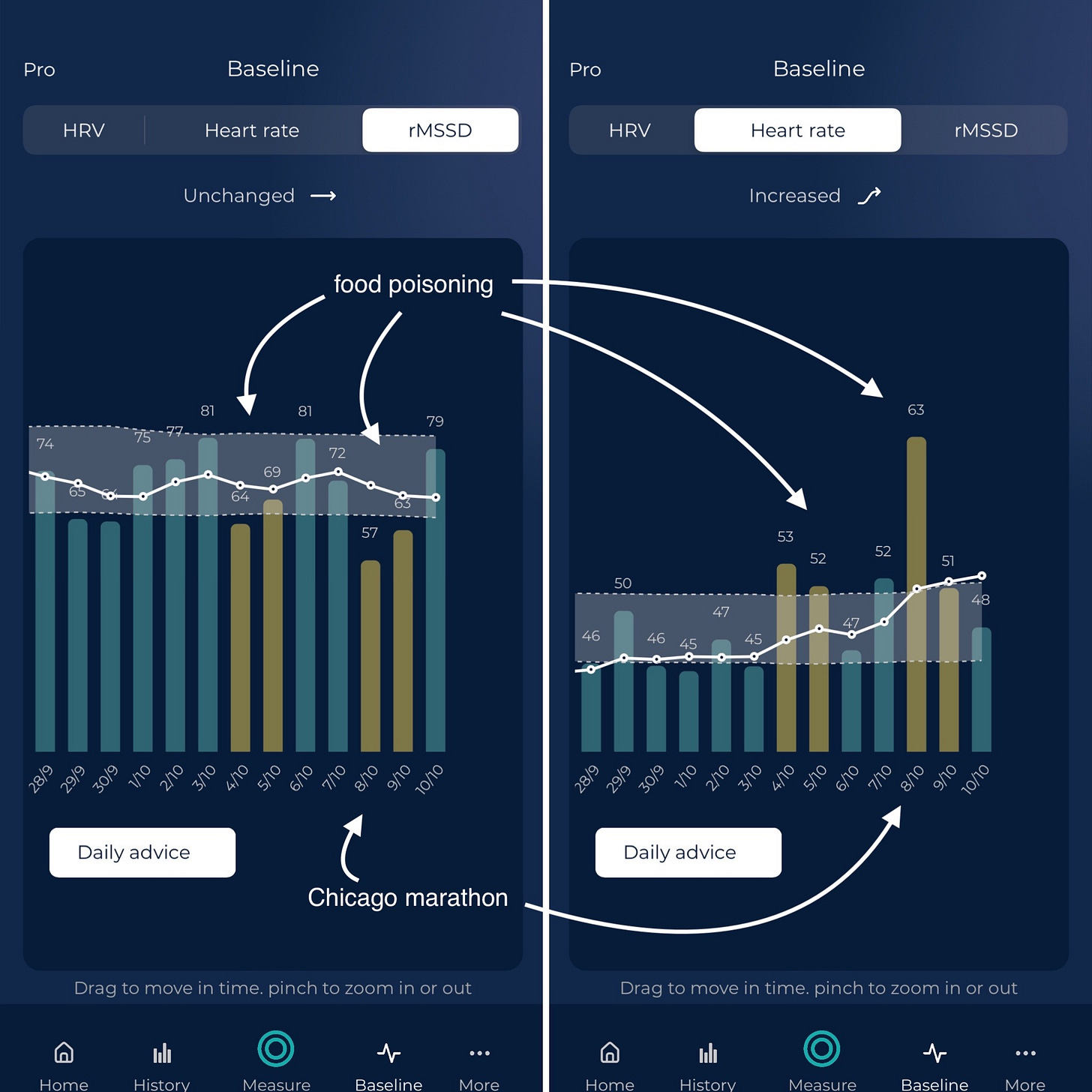
Coincidentally, the Amsterdam marathon was on that next Sunday, so we got two bibs just in case. On Monday I went out for ~25 km, and same thing on Tuesday, feeling better and better. On Wednesday, our last day in Chicago, I opted for a hard session to test the body and see if I was indeed fully recovered. I ran 3 x 2000m and felt great, so I went to catch my plane again quite confident for the upcoming race.
After flying home, jetlag was the last obstacle, as we landed Thursday morning after a sleepless night on the plane, and were completely exhausted. We went for an easy run on Thursday evening, and then I ran just 25 minutes on Friday and Saturday. Friday felt horrible, while Saturday a bit better, but I was really tired as I wasn’t able to sleep much either night.
On Sunday I woke up feeling reasonably well and decided to give it a try.
Race day
Protocols
Nothing new on race day, hence I went for my usual routine:
Wake up 3 hours and 15 minutes before the start. Given the jetlag, I had slept again just 2-3 hours and felt really sleepy, but figured the extra caffeine (see later) would help.
Breakfast 3 hours before the start: I had oats (10 spoons) in soy milk, with jam, berries and a banana, and a slice of bread with jam and butter.
Maurten bicarb 2 hours before the start, together with another 750 mg of sodium (a desperate attempt to counter some of my muscular issues).
I used Saucony’s Endorphin Elites, the only supershoe that is usable by someone with no arch / flat feet, as I am.
I wasn’t sure what to wear for the race, as it was a bit cold and potentially raining a lot. Eventually, we got a hail storm right before, and I started running with a jacket that then, when I realized I was going to be too warm, I was able to throw to some friends who came to support us (thanks for catching it, Coen!). The rest of the race wasn’t too bad in terms of weather, with only a short segment of rain and wind.
The race
I started at perceived effort, but making sure to cap my heart rate at 158-160 bpm, to avoid drama later in the race. I was afraid my heart rate would be elevated as it had been the two days before, possibly due to jetlag and poor sleep, but during the race it was in fact exactly where it was supposed to be, or even a bit lower.
I stayed relaxed, and enjoyed the company of the other runners going at about my pace. I hadn’t planned to run my home marathon, but I was really glad to be there on that day, it made it somewhat special.
In terms of fueling, I tried a slightly more aggressive protocol, with one precision hydration gel (30 grams of carbs) every 6 km, plus one just before the start. For previous marathons, I would have one every 7 km, which makes one less gel total. This would make for 200 grams of carbs in ~3 hours, or 67 grams per hour (2 gels were Maurten, with only 25 grams of carbs, but also including 100 mg of caffeine - I had these at km 12 and 24, and were quite essential in waking up my mind, as I was really sleepy at the start due to jetlag).
If you’ve been following, you know I am plagued my cramps since I started running many years ago. Hence on this day, just like every other time I raced long and hard, I feared the inevitable. After about 27-28 km, my right quad started twitching. At that point I went into managing mode, as opposed to racing mode, trying to limit as much as possible surges and changes of pace, and going really easy on the few ups and downs and bridges. I wasn’t sure what was going to happen here, as in the last race (Winschoten 50 km) I had to stop 3-4 minutes, paralyzed by cramps, just out of the blue. Fortunately the issue didn’t get worse, and I kept a very stable pace. It was painful, but not as much as in Ravenna or Manchester in the previous two marathons, and I did manage to enjoy my day out more than for any other marathon I ran before, which is really the highlight of the day for me.
I agree that the mind plays a key role in endurance sports, but for someone prone to cramps the way I am, it is undeniable that when your body lets you down that way, there is nothing your mind can do to counteract it. The only thing I can do is to play it smart, run a bit conservatively, pace it well, manage the issue when it comes up, and honestly, just hope for the best at that point.
Eventually, I raced the first half in 01:27:52 and the second half in 01:28:45, not bad.
Wrap up
This summer was a great reminder that perfect plans hardly ever materialize, and our ability to adjust and make the most of whatever situation we find ourselves in, is key.
Let’s keep training. Let’s keep learning.
Until next time.
Marco holds a PhD cum laude in applied machine learning, a M.Sc. cum laude in computer science engineering, and a M.Sc. cum laude in human movement sciences and high-performance coaching.
He has published more than 50 papers and patents at the intersection between physiology, health, technology, and human performance.
He is co-founder of HRV4Training, advisor at Oura, guest lecturer at VU Amsterdam, and editor for IEEE Pervasive Computing Magazine. He loves running.
Social:









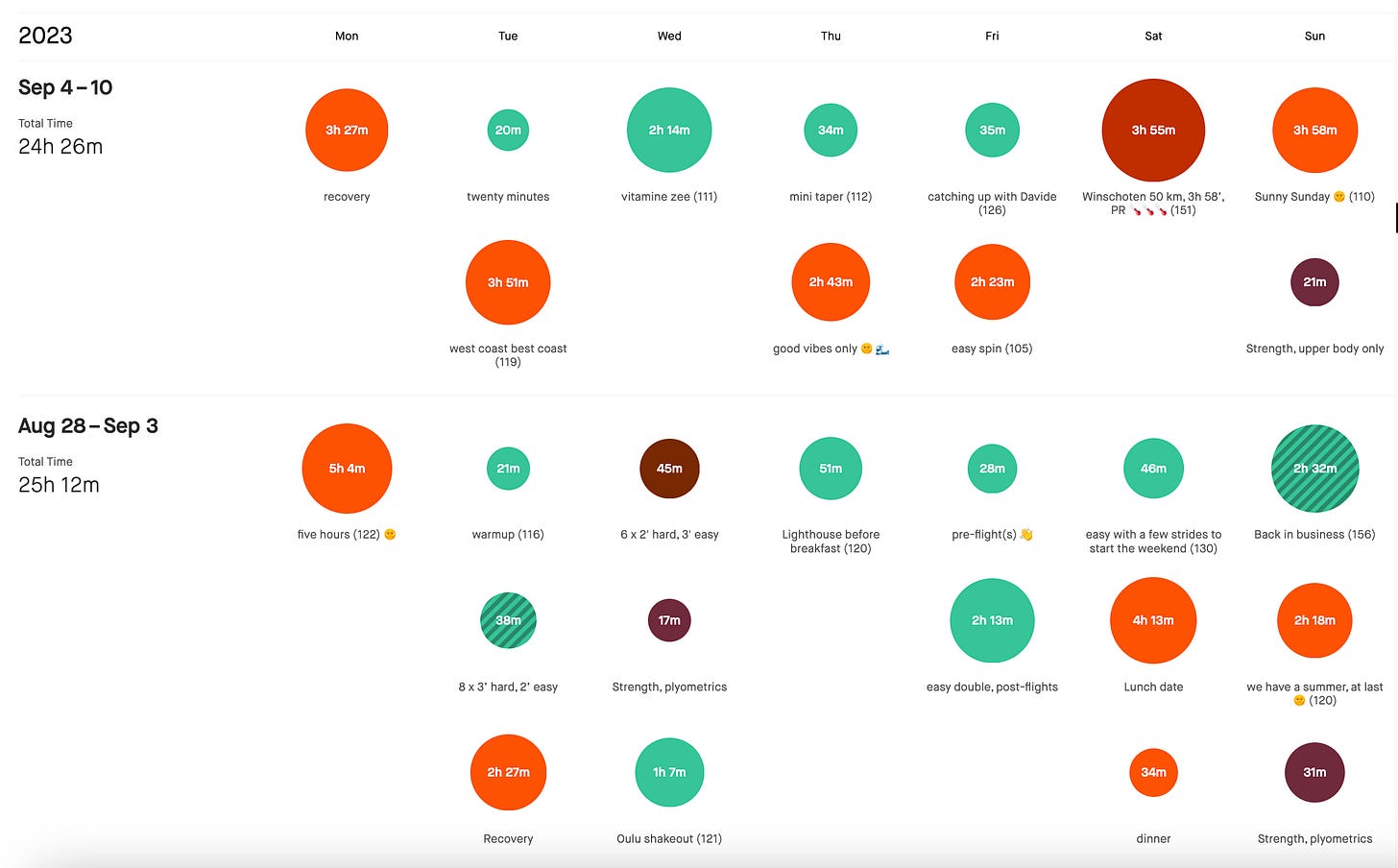

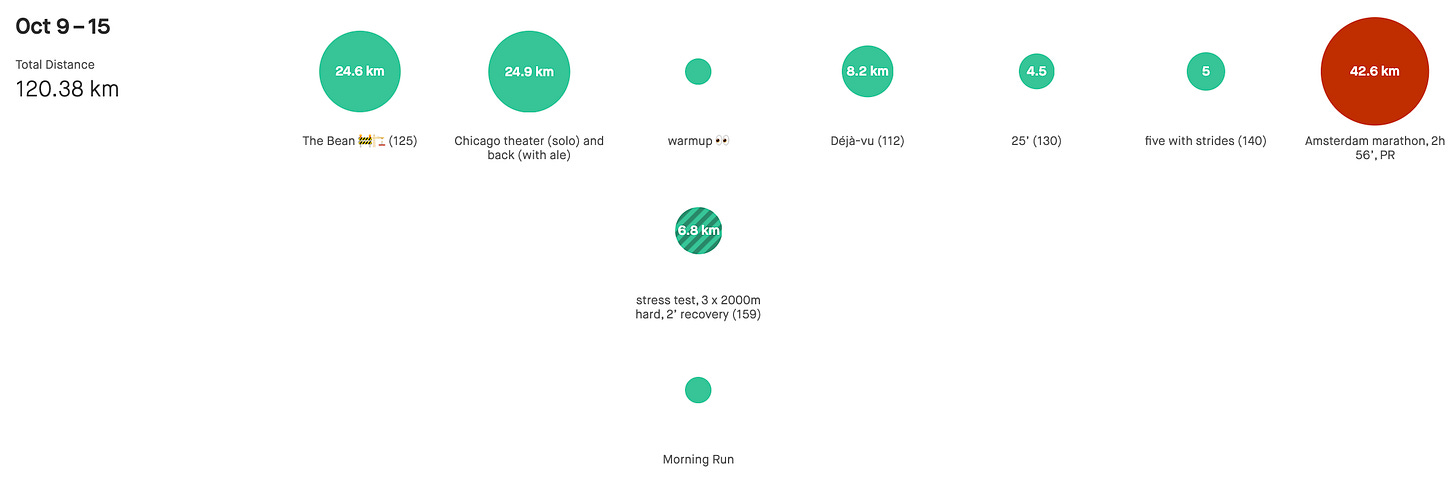
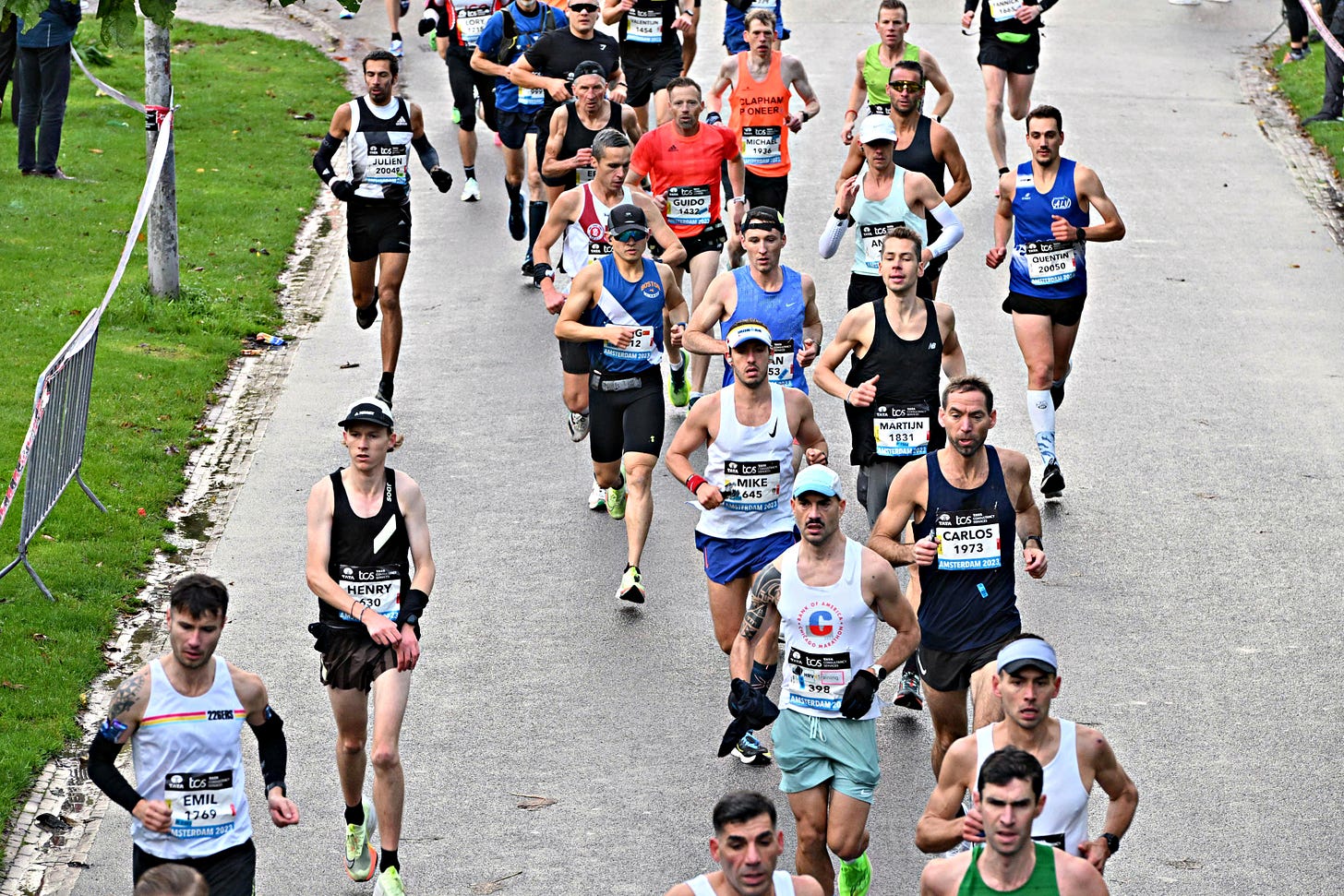
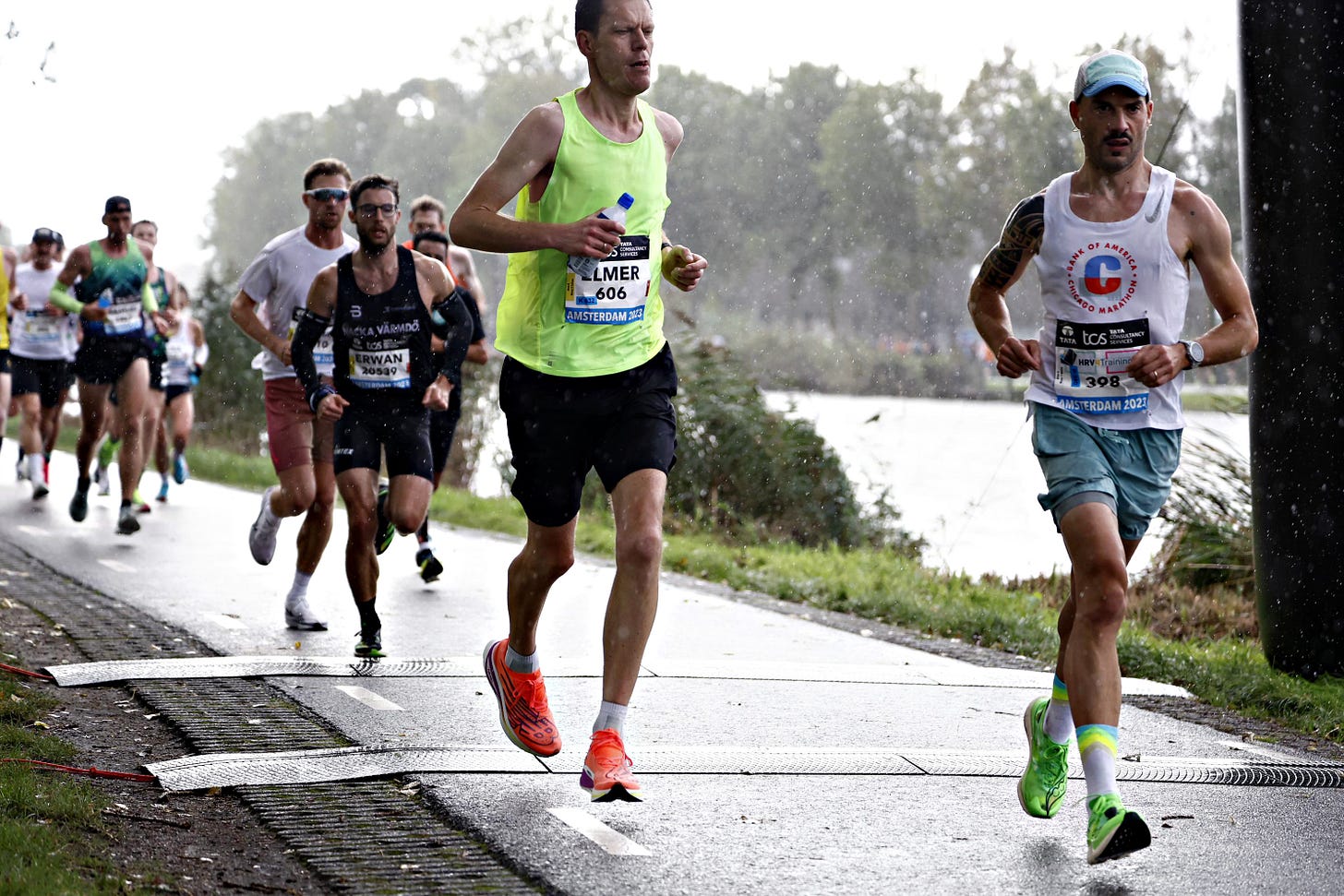




Marco, thanks for sharing your experiences, it is more than you think!